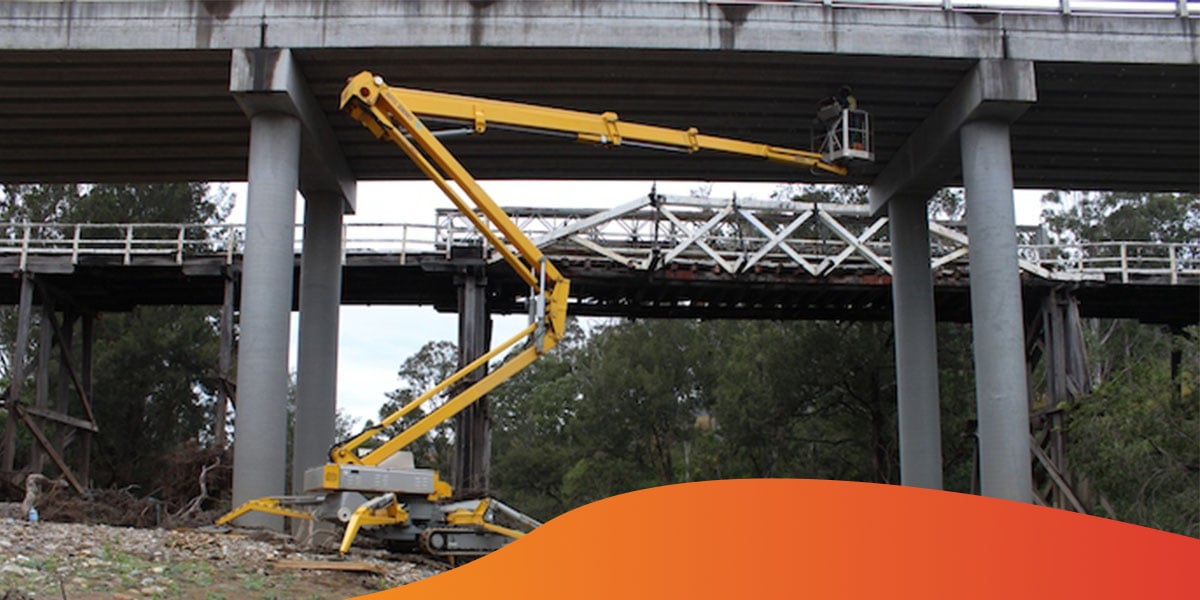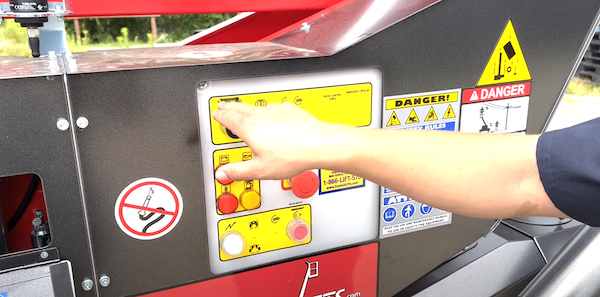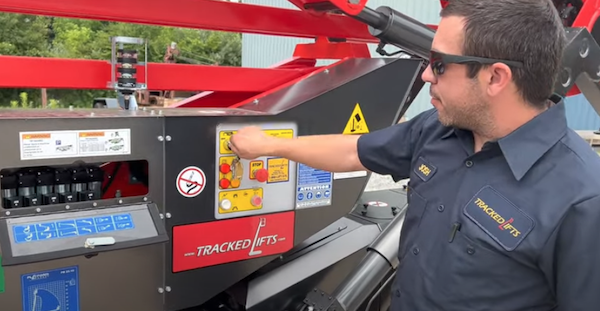Your business uses aerial lifts every day, but do your operators know the terms associated with the equipment? A full understanding of mobile elevated work platforms (MEWP) is crucial, as it allows operators to confidently handle the equipment, protecting themselves and bystanders while performing their tasks effectively. Below is a breakdown of aerial lift definitions and relevant terms workers should know to handle this equipment safely and efficiently.
Understanding Aerial Lifts
An aerial lift, also known as an aerial work platform, aerial device or elevated work platform, is a type of equipment that provides access to elevated areas. Consisting of a bucket or platform and attached to a hydraulic or mechanical lift system, aerial lifts can carry workers, tools or equipment to higher areas.
Your workers should know how to safely use and maintain an aerial lift before operating it. Greater context into these tools can ensure operators safely and properly handle the machinery.
What Is an Aerial Lift?
Any vehicle-mounting device is considered an aerial lift. Common types include cherry pickers, articulating boom lifts and personnel lifts, all of which allow workers to safely perform tasks at varying heights. Aerial lifts are used on various industrial worksites, from warehouses to construction sites.
Regardless of where the machinery is utilized, all operators must receive certification. Failure to receive certification can lead to workers putting themselves or others in danger. It can also lead to OSHA violations, a costly risk for businesses. Workers should understand the different types of aerial lifts and their uses.

-
Scissor Lifts:
A scissor lift consists of a hydraulic platform used to raise or lower workers. Most scissor lifts fall into two usage categories — slab or rough-terrain. Slab scissors are ideal for level or solid work surfaces, while rough-terrain scissors are ideal for operating on soft or uneven terrain. Many feature leveling outriggers that stabilize the lift, as well as treaded or flotation tires depending on the terrain.
-
Vertical Mast Lifts:
Also known as one-man lifts or personnel lifts, vertical mast lifts provide access to elevated and tight-fitting areas, allowing for a small space footprint. They can fit through doorways and passenger elevators, making them ideal for warehouse tasks, though you can also use them to move and manage inventory and perform maintenance around a building.
-
Telehandlers:
Short for "telescopic handlers,” telehandlers are used to lift, move and place material. These versatile machines can be fitted with various attachments to handle materials ranging from lumber to gravel. As a result, telehandlers can adapt to various worksite tasks, from staging initial materials at the beginning of a job to lifting pallets and cleaning job sites at the end of a job.
-
Cherry Pickers:
Cherry pickers and personnel lifts are used to safely raise workers above ground for tasks like warehouse stocking or maintenance work. They come in varying platform options, including drivable electric lifts, power stockers and push-around platform lifts. As a result, they have diverse uses, including picking stock, changing lights or general maintenance.
Aerial lifts are crucial in industries like construction, tree care and trimming, window washing, building inspections, painting, telephone line repair and retail warehouse work. For instance, construction workers can use aerial lifts to install wiring or ductwork in a building or to access HVAC units and pipes. No matter the industry or task, you're bound to find an aerial lift that works for your desired application.
What Does “MEWP” Stand for?
A mobile elevated work platform (MEWP) is elevated platform machinery that workers can easily transport to different work locations. The mobile part means a combination of the aerial device, its vehicle and related equipment. MEWPs can have interchangeable names, such as aerials, access equipment or aerial work platforms. Each device consists of a work platform with controls, a chassis and an extending structure.
Tracked lifts are a type of MEWP that offers increased accessibility. Unlike traditional lifts that rely on outriggers or wheels for stability, tracked lifts include a tracked chassis that offers enhanced stability and mobility. As a result, they are ideal for use on rough or uneven terrain, both outdoor and indoor to safely access elevated areas and tight spaces.
These machines are also highly maneuverable, as they can go forward, back, sideways or even rotate in place, making them a versatile piece of machinery for various industries and applications. A tracked MEWP is one of the most versatile, adaptable and useful lightweight aerial platforms available.
Exploring Boom Lifts
Boom lifts are a type of aerial work platform. While similar to scissor lifts, they can reach higher spaces, allowing operators to complete a variety of tasks at greater elevations. This aerial device is commonly used for tasks like making repairs and painting ceilings. Telescopic and articulating versions offer even greater efficiency and versatility for workers.
What Is a Boom Lift?
A boom lift is an elevated device with a platform used to access high areas. The machinery features a hydraulic system attached to a platform or basket, allowing it to move up or down so operators can reach heights otherwise inaccessible by traditional methods. The arm is attached to a four-wheeled base. The machinery can travel in many directions, making them more versatile than other aerial lifts.
Operators can perform the following tasks with a boom lift:
- Scaffolding
- Painting
- Piping work
- Maintenance projects
- Exterior cleaning
- Utility work
- Orchard work
Boom lifts are commonly used on farms and along utility lines, allowing operators to work at angles in difficult workspaces. With their ability to reach higher and farther than other types of lifts, boom lifts are also ideal for highrise construction and tasks that require maximum reach. Many can reach well over 200 feet, making them capable of reaching up to 17 stories high, which is much higher than scissor lifts.

Telescopic Boom
A telescopic boom is a type of boom lift that features a retractable, single-boom work platform. Its specialized lifting arm is designed with tubular sections that can extend or retract — similar to a telescope — while allowing the boom to reach extended heights. The design ensures you have vertical reach to access overhead tasks while also providing exceptional horizontal reach.
While telescopic booms typically require more space to operate compared to articulating models, they can often reach higher spaces and allow operators to access work from farther distances. This reach makes them helpful on projects where challenging terrain or obstacles prevent close-up access — ironworkers favor them for their maneuverability and reach. Siding installers, roofers, cladders and cleaners also find telescopic booms incredibly useful.
Articulating Boom
The articulating boom is the most recognizable type of boom due to its distinctive shape. It consists of multiple segments connected at the joints, allowing the arm to bend and maneuver with ease. Most models also include a 360-degree base turntable, allowing the device to swivel in any direction.
While they have less horizontal outreach than telescopic booms, they allow more versatility to reach narrow or confined workspaces. Their enhanced flexibility allows articulating booms to articulate at various angles. Operators can use this machinery to access hard-to-reach areas that require precise navigation and positioning, including roofs and utility lines.
Unique Features of Tracked Lifts
Tracked lifts offer both articulating and boom features for increased maneuverability. With a tracked lift, you can safely access even the most tough-to-reach places. A unique tracked chassis allows tracked lifts to fit through narrow entrances while minimizing the impact on working surfaces. Though compact and lightweight, they can easily reach heights up to 140 feet.
Featuring a self-propelled basket utilizing a reliable hydraulic operating system, tracked lifts provide unsurpassed reliability on any task. Tracked lifts are developed with extendable tracks that produce low ground pressure and deliver superior grip in all types of ground conditions. Deployment can be achieved on terraced terrain and over soft, muddy and delicate finished surfaces.
Additionally, you can stay safe when using a tracked lift with simple electro-mechanical limit switches.
Additional Aerial Lift Terms to Know
Other aerial lift terms you will want to be familiar with include:
What Is an Outrigger?
An outrigger is a structural support mechanism that extends from each side or corner of a work platform. Outriggers provide additional stability and balance, especially when working in places with uneven terrain or when the lift's center of gravity must be controlled. Outriggers are typically used with scissor and boom lifts to prevent tip-overs, one of the most dangerous types of aerial lift accidents.
Some lifts come with outriggers, while others are added as an accessory. Outriggers can fold out from the sides, while others can be fastened directly to the machinery's framework. Workers may need to lower older lifts' outriggers by hand to firmly place them on the ground or slab — newer models typically feature hydraulic systems or motors that lower and position the outriggers. Top-of-the-line machines include self-leveling outriggers to automatically lower and adjust the legs for maximum support.
For increased safety, many aerial lifts include interlock devices to keep the boom locked in a stowed position until the outriggers are deployed. Whether your lift comes with an outrigger or you add it to the machinery, you won't want to use an aerial lift without this crucial tool.
What Is a Jib?
A jib is an extended arm attached to the end of a lift's boom. It is typically mounted at the end of the main crane boom or deck, extended at an angle or horizontally from the center of the crane.
Jibs increase the arm length of a lift, enhancing the reach and making them ideal for projects that need materials to be lifted to great heights and distances. The jib also increases the range of motion for the lift, allowing it to move up or down and from side to side, making it especially useful when working in tight spaces.
Most jibs feature a lattice design to reduce the amount of weight they add to the platform and to the lift itself. While some jibs are included with the machinery, they can be removed as necessary based on the lift.
What Does “Turret Rotation” Mean?
A turret rotation refers to a boom's ability to rotate the platform horizontally around a central axis. The rotation is often controlled by an electric or hydraulic mechanism, enabling the operator to change direction or the orientation of the platform and boom without repositioning the entire vehicle.
The hydraulic swivel or electrical slip ring sits at the center of rotation inside the turret at the base of the boom. The booms of truck-mounted aerial lifts are typically mounted on turrets, allowing unlimited and continuous rotation so operators can move the platform to their desired position.
Turret rotation can promote faster handling and higher productivity. If you have a high-density volume warehouse, turret rotation features can save you much more space than standard or articulated lifts. Turret lifts are ideal in applications where relocation or land cost is high, such as large cool room warehouses. At Tracked Lifts, we offer a 180-355-degree turret rotation feature, depending on the model of the lift.
What Does “Stowing” the Boom Mean?
Stowing a boom lift is the process of safely retracting and securing the boom, platform and associated parts for storage or transportation purposes. It involves moving the boom into a more compact position, reducing the machinery's dimensions and ensuring safe transportation and more efficient use of storage space.
To stow the boom, you must return the boom from the working position into the intermediate unstowed position. It's important to check the entire machine for any loose or unsecured items. The platform should be in the stowed position before securing it to a trailer, with straps often placed parallel to the machine's strap guides. When securing the chassis of the boom, it can be stabilized with chains and rigging to prevent damage to the lift.
At Tracked Lift, several of our lifts are lightweight, allowing for safer transportation, and come with an “auto-stow” feature for safety and use of use.

Browse Safe and Efficient Aerial Lifts at Tracked Lifts
With various types of aerial lifts and accessories, training is crucial to handle equipment confidently and safely. When you operate them properly, aerial lifts provide the versatility you need to accomplish any task, across all types of terrains. Understanding this impressive machinery is also crucial to be able to provide regular maintenance.
At Tracked Lifts, we offer top-of-the-line aerial lifts to leverage the safety, efficiency and integrity of your worksite. Our selection includes durable, reliable and easy-to-operate lifts that are ideal for both indoor and outdoor maintenance applications. Use our tracked lifts to complete tasks for all types of projects, from tree care to residential and commercial building maintenance and utility work.
We aim to provide safe, reliable and versatile methods to accomplish your aerial pursuits. With over 15 years of experience, we can provide the tools you need to get your job done safely and efficiently. Contact us today to learn more about our high-performance tracked lifts for your aerial lift needs.





